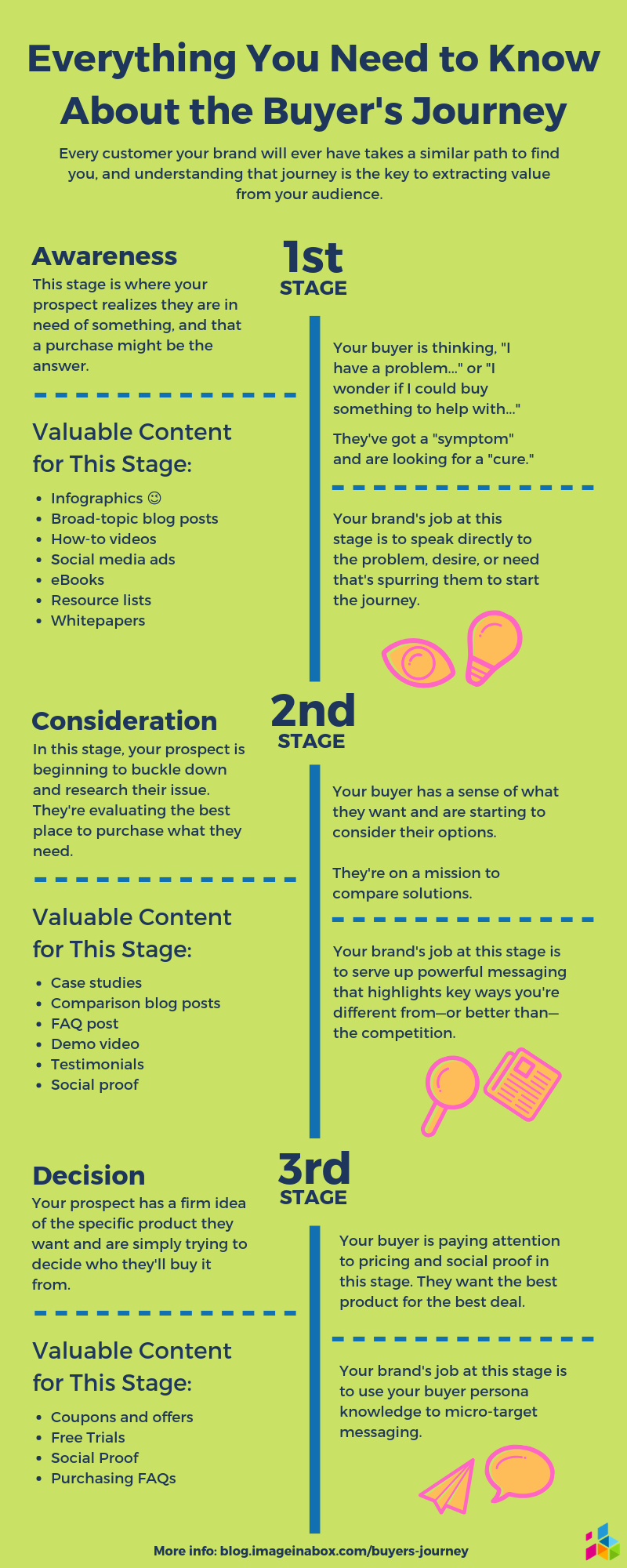Once you’ve made the effort to fully define the various buyer personas of your audience, it’s time to put that knowledge to work. Every customer your brand will ever have walks a similar path to find you, and understanding that journey is the key to extracting value from your audience.
Here’s what you need to know about the buyer’s journey, and how you can leverage that information to optimize your marketing efforts.
What Is the Buyer’s Journey and Why Does It Matter?
 Endless content has been written about the buyer’s journey, and every authority has their own suite of micro-definitions on the theme. But at the most basic level, the buyer’s journey consists of identifying a need or desire, then finding a solution or answer to satisfy it.
Endless content has been written about the buyer’s journey, and every authority has their own suite of micro-definitions on the theme. But at the most basic level, the buyer’s journey consists of identifying a need or desire, then finding a solution or answer to satisfy it.
At some point, each of your customers thought, “I need this” or “I want that,” then attempted to find a product that fit the bill. The path leading them from the initial impulse to the final buying decision? That’s the buyer’s journey.
However, not every journey is the same. For example, some buyers are consumers with a purpose: they have a mission to find a product and will do what it takes to complete that mission. Other buyers are more passive and might not even take the first step (“I need that”) until your marketing makes them aware that a solution exists to begin with.
Understanding what your audience thinks and how they respond to marketing is your best way to shape that journey toward the desired end: the decision to buy your product, not the competitor’s.
With content that’s tailored to specific personas, you can begin setting the terms of the landscape before the customer even starts down the path.
But first, you need to understand the journey itself.
The Buyer’s Journey: 3 Main Stages
Every buyer experiences their path as an individual one, but all journeys include three primary stages:
Awareness Stage
What’s Going on in Your Buyer’s Mind During the Awareness Stage:
This is the most primal and reflexive of the three stages, in which your buyer is simply thinking “I have this problem...” or “I wonder if I could buy something to help with...” or even just “wouldn’t it be nice to have...”
In short, they’ve got a “symptom” and are looking for the “cure.” They may not be able to fully define either end of that equation, but they’re beginning to realize that a purchase might be the answer. Alternately, they may not even be considering a purchase yet, but are primed to jump if you’re able to present a solution to them effectively.
What You Should Do for Your Buyers in the Awareness Stage:
Your brand’s job at this stage is to speak directly to the problem, desire, or need that’s spurring them to start the journey. In many cases, simply being able to identify the problem for the buyer is enough to get them started.
Accordingly, good marketing for this stage has two main ingredients: “we know what you need” and “here’s how we can help.” Once you’ve identified a trigger and positioned your product as the response, you’ll begin to build the brand awareness required to keep the buyer headed your way as they proceed into the next stage of the journey.
For more details on what content to create in the awareness stage, read this blog post.
Consideration Stage
What’s Going on in Your Buyer’s Mind During the Consideration Stage:
At this point, your buyer has some sense of what they’re looking for, and that sense will only solidify as they begin to consider the options available to them. Buyers at this stage are usually on a "mission to compare.” They want to see what the options are, and will start directly putting one product against another to see how factors like pricing, features, or design compare with the competition.
What You Should Do for Your Buyers in the Consideration Stage:
Ideally, your buyer has followed you here from the first stage, but more often you’ll be dealing with buyers who were interacting with other brands during the “awareness” stage and are only stumbling upon your product mid-stream. This makes it even more important that you’re serving up powerful messaging that precisely hits the key triggers for each persona.
Marketing at this stage means providing a clear context for your product in comparison to competitors. At a glance, you need to demonstrate that you understand the product landscape you are operating within, then highlight key ways you’re different from—or better than—the alternatives.
For more details on what content to create in the consideration stage, read this blog post.
Decision Stage
What’s Going on in Your Buyer’s Mind During the Decision Stage:
By this stage, buyers have a firm idea of what specific product they want, and are simply trying to decide who they’ll buy it from. More often than not, purchasing factors make or break decisions for buyers in this stage.
What You Should Do for Your Buyers in the Decision Stage:
Use your knowledge of your buyer personas to micro-target messaging at this stage. Also, take your persona’s preferences into account with pricing, page design, and perceived word of mouth for ultimate marketing success.
For more details on what content to create in the decision stage, read this blog post.
Aligning Your Content Strategy With the Buyer’s Journey
As with all persona marketing, your content needs to match with your buyer personas as much as possible. This means you’ll likely need to create multiple versions of material for each individual stage, catered to individual personas as required to keep your brand visible during their journey.
It’s a good idea to perform an audit of your website and other marketing material, viewed with the eyes of individual personas. Put yourself in their shoes then ask, “can I find what I’m looking for on this page?” or “how long does it take me to find the information I’m looking for?” Any selling point that isn’t immediately visible is likely to never be seen, so structure your sites accordingly.
Finally, use blogs, videos, infographics, and similar mediums to create as much content as is necessary to have individual pieces micro-targeted to individual personas.
Though every buyer’s journey passes through three main stages, individual buyers walk a path that’s all their own. With good content serving up the right messages, you can ensure that your brand’s voice remains the loudest during each of the three stages, straight through to the finish line.
Pin this infographic to easily reference this information at any time!


